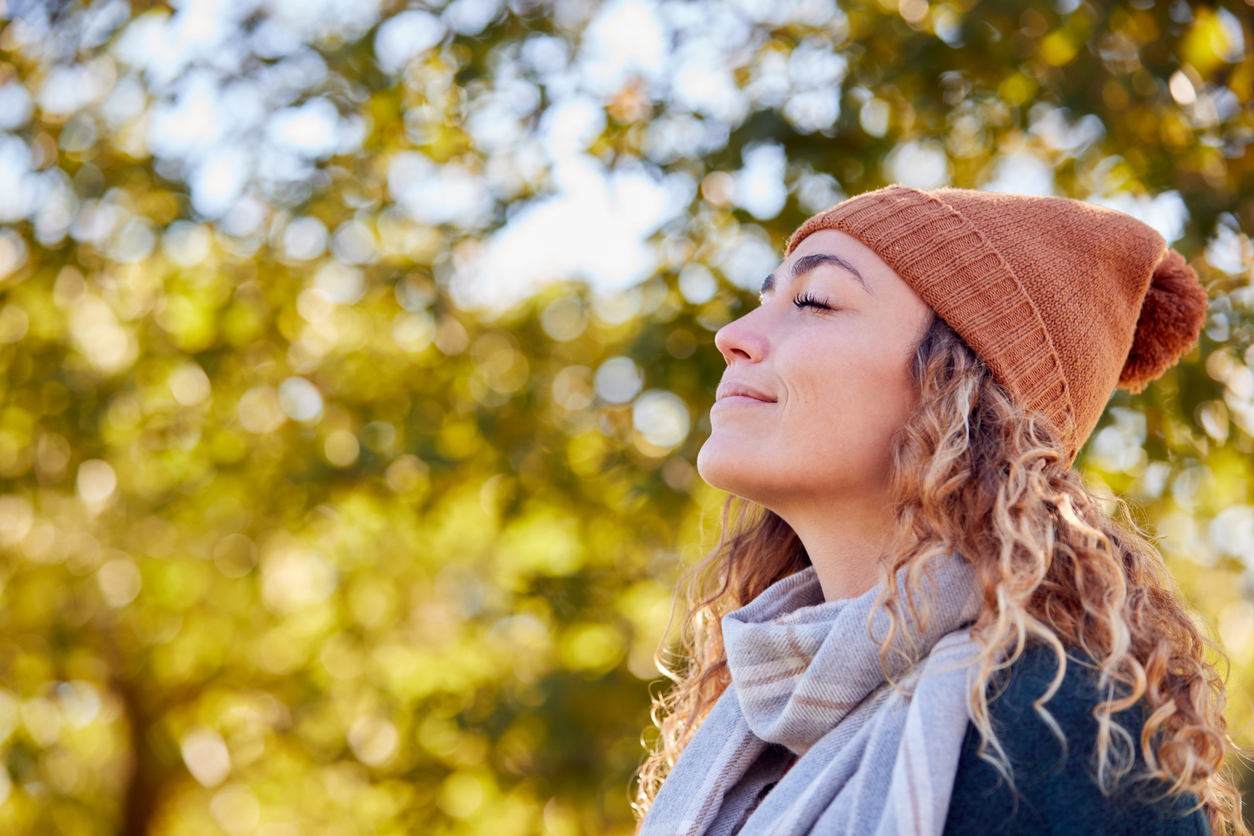Fact: women are still more likely to suffer from burnout than men[1]. The main cause of burnout (according to 80% of us) is the never-ending to-do list of professional and personal tasks we take on- and all too often, self-care can feel like another stressful addition to a burgeoning chore list.
Step forward, gentle wellbeing, a movement that focuses on small but powerful changes that offer bang for the buck in wellness terms- tweaks you can make that deliver true ROI when it comes to happiness, healthiness, and peak performance. Try exchanging the wellbeing tenets below for these micro-steps to take the pressure out of your day and experience an easy and positive difference in your health and wellbeing.
Exchange lengthy Zen for… a five-minute meditation
The powerful benefits of regular meditation are well-known, but there’s no need to get up at 5.30 am to get in an hour of inner peace. Research shows that just five minutes of meditation can greatly impact mood, emotional balance, resilience, and inner calm. Not only that but even regular short periods of meditation have been shown to increase brain size too[2]. Take a few minutes out to sit quietly, letting any thoughts float through your head and away, or to do a bitesize guided meditation on an app such as Headspace or Calm to enjoy a refreshing and energising reset for your day- as well as building a positive wellbeing practice into your life without pressure.
Don’t ‘get things done’… trim your to-do list
Trying to do everything- and trying to do it all yourself- is a quick route to burnout and a common pattern for many high-achieving women. While being effective and dynamic are leadership qualities, part of that equation also involves knowing when to prioritise and delegate. Research shows that people don’t complete 41 per cent of their to-do list tasks, even though there continues to be a pervasive sense in modern life that we are only really succeeding when we are actively ticking off tasks. Take a fresh approach and create headspace and energy for yourself by making time to look at your daily list every morning to actively identify where someone else could take some of the strain or where you can drop some non-essential tasks- a meditation in self-care as well as strategic thinking, it’s also a powerful clarifier for what is really important to your career and business or personal objectives.
Don’t speak… take a breath
Reciting mantras and self-affirmations or talking through problems with others can be helpful to boost confidence- but sometimes all it takes to feel more grounded and confident is to breathe properly. And best of all, you can do it anywhere and at any time (even in a meeting). Breathing deeply activates the parasympathetic system, which calms the body down and stops the signal to the brain to feel anxious. It only takes a couple of minutes to powerfully change your physical state with breath. A simple way to start is to breathe in through the nose for four counts and out through the mouth for four counts over ten breaths. Easy and quick to do at any point or in any situation, the more times you can do this simple practice in a day, the better, bringing oxygen to your thinking brain and clarity and energy to your life.
Replace ‘achievement’ with…a happiness goal
You might know what you want to achieve in your career, but do you know what makes you happy? One of the quickest ways to wellbeing is to understand and prioritise something that makes you happy without necessarily having a tangible return. Happiness goals are often best set as intentions rather than a focus on the outcome- committing to a regular date doing something you enjoy or a weekly experience that restores your sense of self- allowing you to just fully enjoy the process and avoid the trap of ‘constant achievement’. Action for Happiness’s free Ten Days of Happiness programme can be a useful start to help guide you in making small daily actions for greater clarity around your happiness.
Replace yoga with… simple stretching
If you have the time (or inclination) to take a regular yoga class, there’s little better as an all-round strengthening and stretching exercise. However, there’s no need to stress if you can’t make time for the sun salutations. Taking a break during the day to just stretch will allow your body to release tension- research shows two minutes of stretching is enough to increase blood flow and oxygen to your muscles. One quick physical pick-me-up is to stand, knees bent, feet slightly wider than hip distance, and lean forward from the waist, hanging down for a few minutes. Breathe in as far as you can, hold it, then breathe a little more and hold. Repeat several times to elongate the spine and massage the muscles between the ribs and the shoulder blades- prime places for carrying tension.
Skip exercise classes… do micro workouts
The same condensed time approach can take the stress out of keeping fit too. Micro workouts- one-to-ten-minute dance routines and fitness challenges- are one of 2023’s biggest wellbeing trends. And much like HIIT (high-intensity interval training) and Tabata workouts, such bitesize- yet less gruelling- formats are more effective than you might think. Research shows that two or three micro workouts throughout the day may be just as effective as spending an hour at the gym[3]. ‘These short takes on fitness add up to big results and are a fun way to get moving,’ says Adrian Richardson, personal trainer and senior content strategist for Fitbit, who recommends a couple of quick sets of push-ups and squats during the day as easy ways to make fitness gains without stress.
Stop lifehacking… start sensehacking
Forget lifehacking your way to productivity and sensehack your way to tranquillity and balance with another post-pandemic wellness trend- harnessing the power of your senses to help improve cognitive and emotional wellbeing. ’Our senses have more impact over our wellbeing than any of us realise- the sights, sounds, smells of the environment, both those we’re aware of and those that we are not,’ explains Professor Charles Spence, an expert in multisensory perception and author of Sensehacking. He recommends balancing out the ‘sight-heavy’ nature of the modern world by optimising sensory input through touch, taste, sound, and smell. Easy wins include listening to nature sounds or binaural beats, two frequencies at the same time, claimed to induce the same mental state as meditation and diffusing or burning evocative scents while working to sublimate a shift in our mood. The app Zensory can also help with cues and tools to help you connect with all your senses and inspire happier, relaxed feelings that can increase focus and productivity.
Stop thinking deeply… let yourself daydream
Great minds from Archimedes to Freud have long espoused the power of daydreaming, an art somewhat lost in the modern world’s constant screen stimulation and culture of ‘busy’. Letting your mind wander with no fixed destination may feel counterintuitive. However, blocking out half an hour for ‘daydreaming’ in your diary could be your best investment for wellbeing and work performance. Research by the University of Calgary used electroencephalograms to see what happens in our brains when we are engaged in different types of mind-wandering. Those research subjects reporting thoughts that were ‘freely moving’- skipping from thing to thing- showed increased alpha waves in the brain’s frontal cortex, brain activity mapped onto the kind of divergent thinking known colloquially as ‘thinking outside the box’.
Don’t seek stillness… move with the light
Don’t just work on having a seat at the table- think about changing the table if it’s not helping you perform to your full capacity- and move it near to a window. A report by Human Spaces[4] found that people exposed to natural light have a 15 per cent higher level of wellbeing than those who work in environments devoid of nature. In addition, circadian rhythms, the body’s internal clock. are heavily influenced by light, with women shown to be particularly aligned to the early and mid-parts of the day. Work with your natural cycles and give yourself a definite wellbeing advantage- start and finish earlier if you can, and if you’re not able to move your desk beside a window, make sure you are getting ample daylight by putting alerts in throughout the day to take yourself outside to reset.
Don’t just aim high… look up
Where we put our attention can powerfully influence our perspective. Instead of concentrating intensely on trying to have more wellbeing, introduce feelings of calm and openness easily by just looking up at the sky. A study conducted by positive psychology coach Paul Conway found that looking up at the sky, wherever we are, can be an effective form of emotional self-regulation, helping to calm anxiety, enhance mindfulness, clarity and being ‘present’. In addition, it promotes a greater sense of connectedness and ‘awe’– a complex emotion that studies[5] have shown is associated with perspective, humility, creativity and stimulating better immune system health.
[1] https://blog.gitnux.com/burnout-statistics/#:~:text=Women%20are%20more%20likely%20to,also%20caring%20for%20young%20children
[2] https://www.forbes.com/sites/alicegwalton/2015/02/09/7-ways-meditation-can-actually-change-the-brain/
[3] https://www.livescience.com/26772-short-exercise-bouts-benefit-health.html
[4] https://greenplantsforgreenbuildings.org/wp-content/uploads/2015/08/Human-Spaces-Report-Biophilic-Global_Impact_Biophilic_Design.pdf
[5] https://www.newscientist.com/article/mg23531360-400-awesome-awe-the-emotion-that-gives-us-superpowers/





